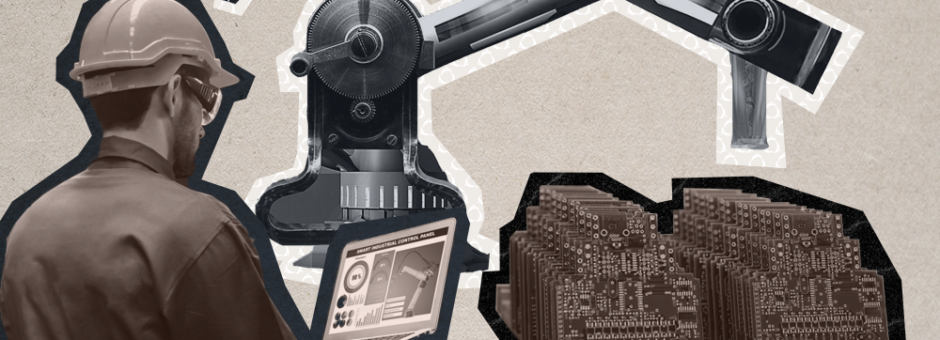Related:
Top Talent Comes At A Premium
As the electronics manufacturing industry provides us with the technology necessary to revolutionize our lives and workplaces, they are simultaneously innovating their own facilities and processes, while leading the way toward Industry 5.0.
Technological Advancements in Electronics Manufacturing
“The electronic manufacturing industry is generally considered a front runner in terms of leading technological advances, both in introducing new ideas and implementing them in their products,” says SMC Integrated Solutions. “The industry is jam-packed with both opportunities and challenges, and those who can balance the two sides of successful operation are bound to lead the competition.”1
Already in place are numerous innovations that set the table for advancement to come. The internet of things has led to cost reduction, product innovation, increased efficiency and improved safety. Predictive maintenance has reduced downtime and extended the life of costly equipment. Big data, long used by large companies, is now being leveraged by small and mid-sized manufacturers to reduce operating costs and refine the manufacturing process. VR & AR, when used in the design phase, can lead to product revisions before the commencement of the production phase.
Industry 5.0
If Industry 4.0 was about increasing the power of machinery, then 5.0 will utilize that machinery to empower the human.
As Andreas Aschbach writes for Forbes Magazine, “The next step in the evolution of manufacturing processes is the notion of a machine-assisted human. This will involve today’s industrial IoT as well as the nascent industrial AI. Today, artificial intelligence has transformed science in laboratories and in R&D. Now, these achievements are needed to support processes on the shop floor with powerful cognitive applications — that is, to make data useful for people so that people and machines can work together as teams to build a stronger, more resilient system.”2
Recruitment in Electronics Manufacturing
As the labour becomes more automated, and the human role more specialized, the economies of domestic manufacturing begin to make more sense. Maximizing the potential of this technology will require a workforce of data scientists, computer coders and other trained specialists. As the economy barrels forward, post-secondary institutions will work to keep up with the demand for these highly sought-after technicians, making recruitment a key success factor.
Life Science and Personal Medical Devices
A major growth area for electronics manufacturers can be found in the personal medical device space. Covid-19 has prompted many consumers to elect for stay at home diagnosis procedures, as opposed to seemingly risky trips to the doctor’s office. This has prompted a flurry of activity in R&D and manufacturing.
“The advanced technology for IoT and connectivity found in other industries has allowed non-medical manufacturing companies to enter the market easily, transferring their knowledge of connectivity to medical device design,” explains SMC. “The increasing demand by consumers to manage their healthcare provides manufacturers with the motivation to expand into medical and other personal-use based EMS production.1
Toronto based sensor and data-collection company WeavAir is building a new optical system that aims to detect the presence of bacteria and viruses in the air.
Pandemic related mental-health concerns prompted non-surgical electronics company Fisher Wallace to create an electrotherapy device designed to treat symptoms of depression, anxiety, and insomnia. The wearable technology induces the brain to produce serotonin, a natural mood stabilizer.2
Other technologies used to measure breathing, pulse, blood pressure, and other biological metrics may not be new, but they are becoming increasingly small, sensitive, and accurate. Integrating these sensor-based data collection units with analytical and diagnostic software will require the expertise of top level scientists and engineers.
Canadian Semiconductor Manufacturing
Further challenging the industry is the much discussed global semiconductor shortage. Trade wars and supply chain complications have created a perfect storm, making life difficult for consumer electronic manufacturers, as well as the auto industry.
Semiconductor manufacturing is dominated by Asia and the US, but some believe that Canada should leverage our abundance of relevant natural resources and STEM-based university graduates to increase our presence in the industry.
“I see this as an opportunity for Canada and the U.S. to build together, for us to collaborate together (and) then to sell them to the rest of the world,” says Canada’s Minister of Small Business Mary Ng. “Canada has a strategic advantage in the already existing robust relations and preferential access to this market.”3
While the Canadian Government has shown some willingness to invest in growth, industry veteran Gordon Harling believes that it’s too little too late in terms of competing with the dominant players. Instead he advocates for a more niche approach.
“My personal opinion is that Canada probably doesn’t want to compete head to head with China or the U.S. on commodity car computers with very low profit margins,” he said. “But we can make the hundreds of other devices that are necessary for the car.”3
Such specialty applications include optical data communication, lighting, and displays, and could provide Canada with an opportunity to capitalize.
Whether bringing new end user products to market or providing key components for assembly, Canada will need to rely upon our brightest minds in order to keep up with the competition. Companies looking to attract this talent will have to offer competitive compensation packages, along with opportunities to contribute to cutting edge work environments.




